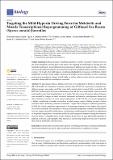Por favor, use este identificador para citar o enlazar a este item:
http://hdl.handle.net/10261/267159COMPARTIR / EXPORTAR:
 SHARE SHARE
 CORE
BASE CORE
BASE
|
|
| Visualizar otros formatos: MARC | Dublin Core | RDF | ORE | MODS | METS | DIDL | DATACITE | |

| Título: | Targeting the mild-hypoxia driving force for metabolic and muscle transcriptional reprogramming of gilthead sea bream (Sparus aurata) juveniles |
Autor: | Naya-Català, Fernando CSIC ORCID; Martos-Sitcha, Juan Antonio CSIC ORCID; Heras, Verónica de las CSIC ORCID; Simó-Mirabet, Paula CSIC ORCID; Calduch-Giner, Josep A. CSIC ORCID; Pérez-Sánchez, Jaume CSIC ORCID | Palabras clave: | Hypoxia Hypo-metabolic state Growth Swimming performance Metabolic landmarks Muscle transcriptome Glycolysis Lipid metabolism Protein turnover Gilthead sea bream |
Fecha de publicación: | 2021 | Editor: | Multidisciplinary Digital Publishing Institute | Citación: | Biology 10(5): 416 (2021) | Resumen: | On-growing juveniles of gilthead sea bream were acclimated for 45 days to mild-hypoxia (M-HYP, 40–60% O2 saturation), whereas normoxic fish (85–90% O2 saturation) constituted two different groups, depending on if they were fed to visual satiety (control fish) or pair-fed to M-HYP fish. Following the hypoxia conditioning period, all fish were maintained in normoxia and continued to be fed until visual satiation for 3 weeks. The time course of hypoxia-induced changes was assessed by changes in blood metabolic landmarks and muscle transcriptomics before and after exhaustive exercise in a swim tunnel respirometer. In M-HYP fish, our results highlighted a higher contribution of aerobic metabolism to whole energy supply, shifting towards a higher anaerobic fitness following normoxia restoration. Despite these changes in substrate preference, M-HYP fish shared a persistent improvement in swimming performance with a higher critical speed at exercise exhaustion. The machinery of muscle contraction and protein synthesis and breakdown was also largely altered by mild-hypoxia conditioning, contributing this metabolic re-adjustment to the positive regulation of locomotion and to the catch-up growth response during the normoxia recovery period. Altogether, these results reinforce the presence of large phenotypic plasticity in gilthead sea bream, and highlights mild-hypoxia as a promising prophylactic measure to prepare these fish for predictable stressful events. | Descripción: | © 2021 by the authors. | Versión del editor: | http://dx.doi.org/10.3390/biology10050416 | URI: | http://hdl.handle.net/10261/267159 | DOI: | 10.3390/biology10050416 | E-ISSN: | 2079-7737 |
| Aparece en las colecciones: | (IATS) Artículos |
Ficheros en este ítem:
| Fichero | Descripción | Tamaño | Formato | |
|---|---|---|---|---|
| Targeting_the_Mild-Hypoxia_Naya_PV_Art2021.pdf | 3,36 MB | Adobe PDF |  Visualizar/Abrir |
CORE Recommender
PubMed Central
Citations
5
checked on 30-mar-2024
SCOPUSTM
Citations
10
checked on 23-abr-2024
WEB OF SCIENCETM
Citations
8
checked on 22-feb-2024
Page view(s)
39
checked on 27-abr-2024
Download(s)
27
checked on 27-abr-2024

